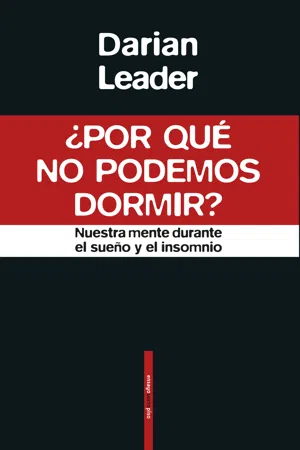![]()
NOTAS
EL NEGOCIO DEL SUEÑO
1. Sigmund Freud, The Interpretation of Dreams, Standard Edition, vol. 4, Londres, Hogarth Press, 1953 [1899], p. 229. [Hay edición en español: La interpretación de los sueños (primera parte), en Obras completas, vol. 4, Buenos Aires, Amorrortu, 1979, p. 241].
2. Hermann Regelsberger, Das Problem des Schlafes, Berlín, Springer, 1933; Ulrich Ebbecke, «Physiologie des Schlafes», en L. Adler et al. (eds.), Handbuch der normalen und pathologischen Physiologie, vol. 17, Berlín, Springer, 1926; Paul Chauchard, Le sommeil et les états de sommeil, París, Flammarion, 1947; Otto Marburg, Der Schlaf, Berlín, Springer, 1928, y Otto Pötzl, «Der Schlaf als Behandlungsproblem», en D. Sarason (ed.), Der Schlaf, Múnich, Lehmann, 1929.
3. Patrick Sisson, «The science (and business) of sleep», Curbed, 6 de octubre de 2016.
4. Ian Oswald, Sleep, Harmonsworth, Penguin, 1966. [Hay edición en español: El sueño. Ensueño, hipnosis, insomnio, Barcelona, Guadarrama, 1977].
5. Robert Aronowitz, Making Sense of Illness, Cambridge University Press, 1998.
6. Dagfinn Aune et al., «Fruit and vegetable intake and the risk of cardiovascular disease, total cancer and all-cause mortality: a systematic review and dose-response meta-analysis of prospective studies», International Journal of Epidemiology, 46, 2017, pp. 1029-1056.
7. Andrew Boorde, «A compendyous regyment or a dyetary of helthe» (1542), en H. J. Deverson (ed.), Journey into Night, Londres, Leslie Frewin, 1966, p. 173.
8. Jon Mooallem, «The sleep-industrial complex», New York Times Magazine, 18 de noviembre de 2007.
9. William Dement, Some Must Watch while Some Must Sleep, San Francisco, Freeman, 1972, p. 4.
10. Robert McGraw y John Oliven, «Miscellaneous therapies», en Silvano Arieti (ed.), American Handbook of Psychiatry, 2, Nueva York, Basic Books, 1959, pp. 1442-1582.
11. Matthew Wolf-Meyer, The Slumbering Masses, University of Minnesota Press, 2012, p. 147.
NOS QUITAN EL SUEÑO
1. Kenton Kroker, The Sleep of Others and the Transformations of Sleep Research, University of Toronto Press, 2007. Sobre el auge de los estudios sobre la apnea, véanse ibídem, y Tiago Moreira, «Sleep, health and the dynamics of biomedicine», Social Science and Medicine, 63, 2006, pp. 54-63.
2. Compárese Gay Luce y Julius Segal, Insomnia, Nueva York, Doubleday, 1966 [hay edición en español: El insomnio, Siglo XXI, 1971], con Dieter Riemann et al., «European guideline for the diagnosis and treatment of insomnia», Journal of Sleep Research, 26, 2017, pp. 675-700.
3. Kenton Kroker, The Sleep of Others, op. cit.
4. A. Roger Ekirch, At Day’s Close, Nueva York, Norton, 2005; Benjamin Reiss, Wild Nights, Nueva York, Basic Books, 2017, y Wolf-Meyer, The Slumbering Masses, op. cit.
5. Nathaniel Kleitman, Sleep and Wakefulness as Alternative Phases in the Cycle of Existence, University of Chicago Press, 1939.
6. Nathaniel Kleitman y Theodore Engelmann, «Sleep characteristics of infants», Journal of Applied Psychology, 6, 1953, pp. 269-282.
7. Eyal Ben-Ari, «Sleep and night-time combat in contemporary armed forces», en Brigitte Steger y Lodewijk Brunt (eds.), Night-Time and Sleep in Asia and the West, Londres, Routledge, 2003, pp. 108-126.
8. Isabelle Rioux et al., «Time estimation in chronic insomnia sufferers», Sleep, 29, 2006, pp. 486-493, y C. S. Fichten et al., «Time estimation in good and poor sleepers», Journal of Behavioral Medicine, 28, 2005, pp. 537-553.
9. Gayle Green, Insomniac, University of California Press, 2008, pp. 270-272.
10. Bernd Feige et al., «The microstructure of sleep in primary insomnia», International Journal of Psychophysiology, 89, 2013, pp. 171-180.
11. Peter Stearns et al., «Children’s sleep: sketching historical change», Journal of Social History, 30, 1996, pp. 345-366.
12. Thomas Anders y Pearl Weinstein, «Sleep and its disorders in infants and children: a review», en Stella Chess y Alexander Thomas (eds.), Annual Progress in Child Psychiatry and Child Development 1973, Nueva York, Bruner/ Mazel, 1974, pp. 377-395.
13. Matthew Walker, Why We Sleep, Londres, Allen Lane, 2017, pp. 107 y 301.
14. Steven Lockley y Russell Foster, Sleep, Oxford University Press, 2012, p. 91. Esos datos han sido cuestionados recientemente por Rachel Carey y Kiran Sarma en «Impact of daylight saving time on road traffic collision risk: a systematic review», BMJ Open, 7, 2017, e014319.
¿UN SUEÑO O DOS?
1. E. P. Thompson, «Time, work-discipline and industrial capitalism», Past & Present, 38, 1967, pp. 56-97, y Vanessa Ogle, The Global Transformation of Time, 1870-1950, Harvard University Press, 2015.
2. Walter Benjamin, The Arcades Project, Cambridge (Massachusetts), Belknap Press of Harvard University Press, 1999, p. 737. [Hay edición en español: El libro de los pasajes, Madrid, Akal, 2005, p. 743].
3. Russell Foster y Leon Kreitzman, Rhythms of Life, Londres, Profile, 2004.
4. Matthew Wolf-Meyer, The Slumbering Masses, University of Minnesota Press, 2012, p. 165.
5. Roger Ekirch, At Day’s Close, Nueva York, Norton, 2005.
6. Craig Koslofsky, Evening’s Empire: A History of the Night in Early Modern Europe, Cambridge University Press, 2011.
7. Ekirch, At Day’s Close, op. cit., y «The modernization of Western sleep: or, does insomnia have a history?», Past and Present, 226, 2015, pp. 149-192.
8. Sasha Handley, Sleep in Early Modern England, New Haven (Connecticut), Yale University Press, 2016, p. 151.
9. Thomas Wehr, «In short photoperiods, human sleep is biphasic», Journal of Sleep Research, 1, 1992, pp. 103-107.
10. Véase un análisis de esta controversia en Benjamin Reiss, Wild Nights, Nueva York, Basic Books, 2017, pp. 34-37.
DESCONECTAR
1. Paul Glennie y Nigel Thrift, Shaping the Day: A History of Timekeeping in England and Wales, 1300-1800, Oxford UniversityPress, 2009, y véase l...
